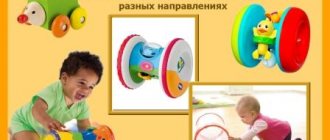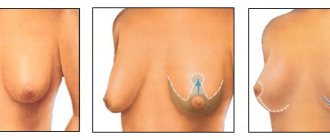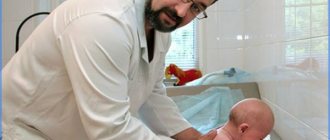Feeding and sleeping
Food and sleep are the two most important things for a newborn. It is best to breastfeed your baby - it is more convenient for the mother and healthier for the baby. You need to feed your baby “on demand,” that is, when he asks. Routine feeding - every 3 hours - is a relic of the past. As a rule, after some time, children themselves establish a feeding regime that is convenient for them (but not strict!). For example, they start eating every 2 hours. This is the regime that parents must follow.
At night, the baby also feeds on demand, so it is not advisable to immediately allocate a separate room for him - the mother will have to run back and forth several times a night. Many parents move the crib close to theirs or place the baby with them.
In the intervals between feedings, the baby most often sleeps. In the first month, children sleep 14-19 hours a day. With each month, the periods of wakefulness increase, and by six months the child sleeps 13-14 hours a day. Moreover, if in the first months the baby can wake up every 1.5-4 hours, regardless of whether it is night or day, then from about eight months many children can already recognize the time of day and sleep from 10 pm to 6 am. And during the day they sleep 2 times for 2 hours. By the age of 1-1.5 years, the baby begins to sleep “like an adult” - all night and once during the day, after lunch.
whether to swaddle his child while he sleeps.
Many people swaddle their children so that they do not wake themselves up with their movements; some children sleep more comfortably this way. Now most doctors believe that a child should have free arms and legs, as this is necessary for normal psychomotor development. Therefore, starting from the second month, it is better to wear rompers for your baby.
What does a healthy newborn baby look like?
What does a newborn look like when it has just been born? The delicate skin of the baby in the first days is red in color with pronounced fine-scaly peeling, but after 7-10 days it will become pink and smooth. The skin of a newborn is rich in blood vessels; more than half of the total blood volume is in the skin. The sweat glands are underdeveloped, and the function of the sebaceous glands increases even before birth, producing a lubricant that coats the baby’s body and facilitates movement through the birth canal.
In the photo of what newborn babies look like, you can see that the lubricant is located in both the axillary and inguinal folds:
Take your time to thoroughly cleanse the skin of it, it plays a protective role and will disappear as the baby bathes. Over the entire surface of the skin, especially on the shoulders and back, you will find soft vellus hair, which will gradually disappear.
Sometimes, if a child is restless, some ancient old woman or ignorant neighbor will say: the bristles on his back are prickly, that’s why he screams. And he will offer a folk remedy for removing “bristles”: make a lump of bread crumb and roll it along the back. After this procedure, previously invisible vellus hairs, twisting together in several pieces, really resemble black prickly stubble, which the “healer” presents as proof of her innocence. Don't be fooled by the ignorant: a human baby can't have stubble!
A photo of a healthy newborn baby shows that he almost always lies in a boxer position: his arms with clenched fists are bent at the elbows, and when you try to straighten them you feel resistance:
The legs are also bent at the knee and hip joints and do not want to straighten. And don't try to do that. In my mother’s tummy, this position allowed it to take up as little space as possible, and now the usual position is supported by increased muscle tone in the upper and lower extremities.
The arms will straighten by 2-2.5 months, and the legs by 4 months. And don’t even think about swaddling your baby tightly, forcibly straightening his legs, supposedly to create harmony. Tight swaddling has once and for all been recognized as harmful, disrupting deep breathing, promoting the appearance of diaper rash on the skin, and suppressing the freedom and development of the child’s personality.
Look at the photo of what a newborn baby looks like - at first glance, the baby seems disproportionate, he has a large head on a short body with thin arms and legs:
This ratio will soon change, but for now his head is relatively large. In a full-term newborn it is 1/4, in a premature newborn it is 1/3, and in an adult it is only 1/8 of the body. The head circumference of a full-term baby is 34-35 cm. While stroking the baby's head, you will feel a small depression above the forehead, devoid of bone tissue, and feel the pulsation of this area. This place, located between both parietal and frontal bones, has the shape of a diamond with sides 2 cm long and is called the greater fontanel. So that after birth the child’s brain has the opportunity to grow and improve, nature did not limit its freedom with a dense cranium, but left connective tissue between the bones, which allows the flexibility of the skull while passing through the birth canal and provides the brain with conditions for further growth and development. Expansions of connective tissue at the border between bones form the so-called fontanelles, of which only two can be identified - large and small. The small fontanel is located closer to the back of the head and closes in the first months, while the large one remains open for up to 9-12 months.
Immediately after birth, the doctor examines the baby's genitals and perineum to make sure the girl has an anus and vagina. Now let’s take a closer look at the condition of the external genitalia. In girls, the labia majora may be swollen, and bloody discharge is often noted from the genital slit. This is due to the influence of maternal hormones and will disappear without a trace in 2-3 days.
Feel your son's scrotum: are the testicles in place? They are defined by dense rounded formations the size of beans. If only one testicle is found or none is found, you will have to contact a pediatric surgeon. In the fetus, the testicles are located retroperitoneally on the posterior wall of the abdomen. From the 6th month of the intrauterine period, the process of descent of the testicles through the inguinal canal into the scrotum begins. For most boys, this process ends before birth. But sometimes there is a delay in this process, and the baby is born with one testicle or an empty scrotum. This condition is called cryptorchidism. If the movement of the testicle has stopped in the inguinal canal or in the abdominal cavity, where the temperature is 1.5-2 °C higher than in the scrotum, then the development of spermatogenic tissue may be impaired. And this can lead to irreversible consequences in the future. Timely seeking medical help and moving the testicle to its rightful place contribute to the restoration of its normal structure and reproductive function in adulthood. Sometimes the testicle descends into the scrotum on its own. In any case, the child should be examined by a pediatric surgeon in the first months of life.
Now let's look into the baby's mouth.
Pay attention in the photo to what the mucous membrane of a newborn looks like - it is bright pink due to many blood vessels, and is somewhat dry because the salivary glands are not yet active enough:
The oral cavity is almost completely filled with a relatively large tongue. This is how nature took care of the baby, providing him with a tool for extracting milk from the mother’s breast. The act of sucking involves the muscles of mastication and the muscles of the lips, as well as dense fat pads located in the thickness of the cheeks. They are called “Bishat's lumps” and are present even in low-weight premature babies, making it easier for them to suck. The salivary glands function from birth, but their activity is low, and little saliva is secreted, so the oral mucosa is dry and easily susceptible to pathological processes, primarily the development of thrush. If, when crying, you find 2 symmetrically located white peas on the roof of your mouth, do not be alarmed. This is another feature of the newborn period, the so-called Epstein pearls, which will soon disappear.
Every mother should know what the eyes of a newborn baby look like, because they are almost always closed by swollen and heavy eyelids. But an attentive mother can sometimes see hemorrhages under the conjunctiva, which arose due to increased pressure on the head as it passes through the birth canal. To protect the eyes from infection by microorganisms, mainly from gonococci, which can enter during passage through the birth canal, the midwife instills a solution of silver nitrate into the conjunctival sac or applies an antibacterial ointment.
When palpating the abdomen, the doctor determines the condition of the liver and spleen and always asks whether the newborn has had stool. On the first day of life, the original feces - meconium - are usually released; it has a creamy consistency and a dark green color. While in the womb, the baby swallowed amniotic fluid with exfoliated epithelial cells and metabolic products contained in it. Now he brings it out. After a few days, the stool will take on a normal character for a newborn: yellow liquid porridge with a sour smell. From the first minutes of life, the intestines are populated by microbes, forming their own microflora.
The doctor will not ignore your baby’s hip joints and feet to rule out congenital dislocation of the hip joints and congenital clubfoot. These pathological conditions, detected in the first days of life, can be easily corrected, and late diagnosis leads to more complex and lengthy treatment.
Now you know what a newborn baby should look like, it’s time to find out what unconditioned reflexes the baby has from the first days of life.
Diapers and hygiene
One of the most pressing issues in child care remains the use of diapers. The debate about whether they are harmful or not continues to this day. The main argument of opponents of diapers is that boys who wore diapers as children may develop infertility. However, scientists believe that this is not the case. Modern “breathable” diapers are quite safe for both girls and boys.
Naturally, wet diapers need to be changed regularly. The maximum time for wearing a diaper is 4-6 hours. When changing a diaper, the baby’s bottom must be washed and anointed with a special “diaper rash” cream. From time to time, the diaper can be removed, leaving the baby to lie down or crawl with a bare bottom (although this is not necessary).
Examination of a child in the first 5 minutes of life: what the doctor records
When examining the baby, the pediatrician pays attention to other indicators. Quite often, at this moment it is possible to notice that the newborn has an infection. In this case, the child will begin to be treated in the maternity hospital. The doctor also checks whether the baby has dislocations, fractures, or other injuries, and assesses his maturity. There are signs by which you can assess whether the baby is full-term. For example, do your nails extend past your fingertips? Are there folds of skin all over the foot? Are the breast nipples clearly defined?
Reflexes are also checked: when the doctor places the newborn on his back, he instinctively throws his arms to the sides, stretches his legs and throws his head back (Moro reflex). The baby, supported in an upright position, begins to rearrange its legs, as if “walking.” This is a sign showing that he reacts to stimuli according to his age.
The midwife fills out the bracelets: writes on them the last name, first name, patronymic, mother’s birth history number, gender of the child, weight, height, hour and date of birth. The bracelets are tied to the baby's hands and over the diaper.
In our maternity hospital, the baby is put to the breast in the first five minutes of life, of course, unless he or the mother has complications that make this impossible. In any case, we try to give the baby breast milk in the delivery room.
Mom and baby are in the maternity ward for 2 hours, where doctors monitor them. If the mother or baby has serious problems, the child will be transferred to the intensive care unit immediately after birth. Healthy mother and baby in our maternity hospital are transferred to the postpartum ward to stay together. There are all conditions to establish breastfeeding on demand.
It may seem to mothers that these procedures take a very long time. Actually this is not true. If the baby is healthy, the doctor will only need a few minutes for all the necessary manipulations. Most of them are carried out when the mother experiences separation of the placenta or when the gynecologist examines her after childbirth. So the separation of mother and baby does not occur for long. At the same time, the information that the pediatrician receives from the first examination is priceless. In emergency cases, the life and health of the child may depend on it.
Walks
You need to walk a lot with your child. You can start walking from the 10th day of a baby’s life, and the air temperature outside should not be lower than -10 degrees. The first walk usually lasts 10 minutes, and each subsequent walk is increased by 5 minutes. Ideally, you should walk for 1.5 - 2 hours 2-3 times a day, in any weather, avoiding too hot and too frosty. In cold weather, this hardens the child, and in warm and sunny weather it contributes to the formation of vitamin D in the baby’s body, which prevents the development of rickets. It is not recommended to leave the stroller with the child in direct sunlight.
Naturally, at first a small child only sleeps during a walk. Many mothers don’t want to spend all day wandering the streets with a stroller when there are a lot of household chores waiting for them at home. Therefore, in the first months, an excellent solution may be for the child to sleep on the balcony (though not all children agree to sleep in a stationary stroller). Later, the baby will begin to be more actively interested in the world around him, learn to sit down, and you will have to walk “for real.”
First day after birth. Is it really all over?
What happens to a woman immediately after giving birth? What does a newborn actually look like? What will happen in the maternity hospital on the very first day of your new life.
Read more
fontanelles
They are non-ossified areas between the bones of the skull - small depressions that you find when stroking the baby’s head.
diamond-shaped fontanel When you put your fingers on it, you may feel a slight pulsation - this is normal. A bulging or tense large fontanelle is an alarming sign and requires contacting a doctor.
The small fontanelle has a triangular shape and is located in the occipital region - the junction of the parietal bones with the occipital bone.
Usually the large fontanel closes at about the age of one year, the small one within a few months after birth.
Face
It bears the “imprint” of the colossal work that the baby had to do, making his way “to freedom.” Sometimes the face looks “bruised” with deep wrinkles. The palpebral fissures are often narrowed, the eyelids are swollen and swollen.
After a few days, the skin smooths out and the swelling goes away.
Eyes
They often “float”, move away in different directions or converge at the bridge of the nose, and the gaze does not linger for long on one object. At the same time, the child squints - this is the norm. The reason is weakness of the eye muscles. By three months, strabismus usually goes away, but in some babies it can persist until six months of age.
Red burst vessels may be visible on the whites of the eyeballs - hemorrhages that occurred during the passage of the baby through the mother’s birth canal.
Looking at the color of the eyes , adults wonder: are the eyes of mother’s or father’s, grandmother’s or grandfather’s? It's hard to say. At birth, the baby's eyes are usually bluish-gray, but may initially be brown. The final eye color is established around the age of six months or closer to a year.
Sources
- Vasileiou E., Simpson CR., Shi T., Kerr S., Agrawal U., Akbari A., Bedston S., Beggs J., Bradley D., Chuter A., de Lusignan S., Docherty AB., Ford D., Hobbs FR., Joy M., Katikireddi SV., Marple J., McCowan C., McGagh D., McMenamin J., Moore E., Murray JL., Pan J., Ritchie L., Shah SA. , Stock S., Torabi F., Tsang RS., Wood R., Woolhouse M., Robertson C., Sheikh A. Interim findings from first-dose mass COVID-19 vaccination roll-out and COVID-19 hospital admissions in Scotland : a national prospective cohort study. // Lancet - 2021 - Vol - NNULL - p.; PMID:33901420
- Noureddine S., Avedissian T., Khatib N., Irani J. Towards better out-of-hospital cardiopulmonary resuscitation: A survey of nurses. // J Clin Nurs - 2021 - Vol - NNULL - p.; PMID:33896056
- Eroglu TE., Jia L., Blom MT., Verkerk AO., Devalla HD., Boink GJJ., Souverein PC., de Boer A., Tan HL. Sulfonylurea antidiabetics are associated with lower risk of out-of-hospital cardiac arrest: Real-world data from a population-based study. // Br J Clin Pharmacol - 2021 - Vol - NNULL - p.; PMID:33896015
- Kim KH., Ro YS., Park JH., Kim TH., Jeong J., Hong KJ., Song KJ., Shin SD. Association between case volume of ambulance stations and clinical outcomes of out-of-hospital cardiac arrest: A nationwide multilevel analysis. // Resuscitation - 2021 - Vol - NNULL - p.; PMID:33895233
- Ong J., O'Connell F., Mazer-Amirshahi M., Pourmand A. An international perspective of out-of-hospital cardiac arrest and cardiopulmonary resuscitation during the COVID-19 pandemic. // Am J Emerg Med - 2021 - Vol47 - NNULL - p.192-197; PMID:33894661
- Croughan S., Barrett M. Associations between initial serum pH value and outcomes of pediatric out-of-hospital cardiac arrest. // Am J Emerg Med - 2021 - Vol - NNULL - p.; PMID:33888354
- Naylor K., Torres K. Transitioning to Online Learning in Basic Life Support Due to the Covid-19 Pandemic, to Battle the Fear of Out of Hospital Cardiac Arrest; a Presentation of Novel Methods. // J Med Internet Res - 2021 - Vol - NNULL - p.; PMID:33886488
- Cheskes L., McLeod S., Cheskes S. Is there a role for ECMO-facilitated resuscitation for the management of out-of-hospital cardiac arrest (OHCA) with refractory ventricular fibrillation (VF)? // CJEM - 2021 - Vol - NNULL - p.; PMID:33886109
- Ovaskainen K., Ojala R., Gissler M., Luukkaala T., Tammela O. Is birth out-of-hospital associated with mortality and morbidity by seven years of age? // PLoS One - 2021 - Vol16 - N4 - p.e0250163; PMID:33882082
- Miyamoto Y., Matsuyama T., Goto T., Ohbe H., Kitamura T., Yasunaga H., Ohta B. Association between age and neurological outcomes in out-of-hospital cardiac arrest patients resuscitated with extracorporeal cardiopulmonary resuscitation: a national multicentre observational study. // Eur Heart J Acute Cardiovasc Care - 2021 - Vol - NNULL - p.; PMID:33880567











